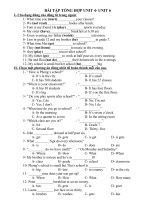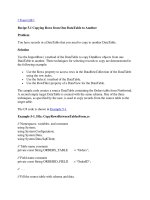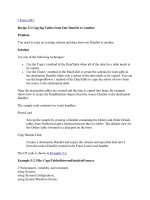From syllabus design to curriculum design
Bạn đang xem bản rút gọn của tài liệu. Xem và tải ngay bản đầy đủ của tài liệu tại đây (2.37 MB, 33 trang )
From Syllabus Design to Curriculum Design
Kelly 9710001M
Dora 9710011M
From Syllabus Design to Curriculum Design
The Quest for New Methods
Changing Needs for Foreign Languages in Europe
English for Specific Purposes
Needs Analysis in ESP
Communicative Language Teaching
Emergence of a Curriculum Approach in Language
Teaching
The Quest for New Methods
World War II immigrants, refugees and
foreign students UK, Canada, US,
Australia
There was much greater mobility of
peoples in air travel, international
trade and commerce.
The Quest for New Methods
Whites(1988,9) comments:
The emergence of the USA as an Englishspeaking superpower
The industrial and technological developments
of the nineteenth and twentieth centuries.
The Quest for New Methods
Explore new teaching method
linguistics organization & structure
of language
A new approach Oral Approach
Situational Language Teaching British
The Quest for New Methods
Situational Language Teaching in British
A structural syllabus with graded vocabulary levels
Meaningful presentation of structures in contexts
PPP method- Presentation/ Practice/ Production
The Quest for New Methods
1950s- Situational Approach
British, Australia, Malaysia, India, Hong Kong
1960s- Audiolingual Method
United States
1978s- Audiovisual Method
Europe
The Quest for New Methods
Audiolingual Method in US
Habits are strengthened by reinforcement
Foreign language habits are formed most
effectively by giving the right response
Language is behavior
Changing Needs for Foreign
Languages in Europe
The upsurge in English language teaching
(since the mid-1950s~1960s)
A Language Teaching Revolution
a) Introduce new methods and materials
b) WHY/ HOW people learn a second language
c) Evaluation results
Jupp&Hodin(1975)
Changing Needs for Foreign Languages
in Europe
In 1969s-The Council of Europe
a) removed language barriers
b) modern language enrichment
c) the modern Europe language
In 1970s- The Decision of school system
In 1971s- The Unit-credit System for Adults
Communicative Language Teaching
in Europe
Whole context of teaching and learning
The need for society
The need for learners
English for Specific Purpose
To make the courses relevant to learners’ needs
The Language for Specific Purpose Movement
The ESP approach concerns
a) the need for Non-English background students
b) the need for employment
c) the need for business purpose
d) the need for migrants
English for Specific Purpose
University of Michigan
language patterns and vocabulary
A number of selected texts appeared in 1960s
a) The selection and gradation books
b) General English books
c) Specialized English books
d) Word Frequency Counts
e) Discourse Analysis
English for Specific Purpose
The widely used books
Course in Basic Scientific English
(Ewer & Latorre,1969)
The merits of this book:
a) three million words of scientific English
b) covering ten areas of science & technology
c) sentence patterns
d) structural words
e) non-structural vocabulary
English for Specific Purpose
The determine of “register ”:
* what is actually taking place
* what part the language is playing
* who is taking part
(Halliday 1978,31)
English for Specific Purpose
In 1970s the ESP approach:
Register Analysis
distinctive patterns of occurrence of vocabulary,
verb forms, noun phrases, and tense usage.
Three categories describes the register:
* the research process
* the vocabulary of analysis
* the vocabulary of evaluation
(Martin,1976)
English for Specific Purpose
In 1970s the ESP approach:
Discourse Analysis
identify the linguistic structure of longer
samples of speech or text.
* analysis of units of organization within texts
* speech events
* examines patterns
English for Specific Purpose
In 1970s the ESP approach
Discourse analysis:
The problem-solution structure
a) Introduction
b) Background
c) Argument
d) Conclusion
Needs analysis in ESP
The view of Stevens:
(a) Restriction—Basic Skills of Understanding Speech,
Speaking, Reading, and Writing.
(b) Selection—Vocabulary, Patterns of Grammar, and
Function of Language.
(c) Themes and Topics—Themes, Topics, Situations,
and Universes of Discourse.
(d) Communicative Needs—For Communication
Needs analysis in ESP
(a) Learner’s Needs are Communicative Ability.
(b) Preparation for Learners to Carry Out Tasks
(c) Try to Perform a Role (Robinson)
ex: waiters, food technology
(d) Learners, Teachers, and Employers’
involvement (Richterich and Chanceril)
Needs analysis in ESP
Munby’s Systematic Approach:
Needs Analysis in ESP Course Design and
Two Dimensions of Needs Analysis:
(a) Specification for the Target-Level
(b) Turning the Information into an ESP Syllabus
Needs analysis in ESP
Schutz and Derwing’s Summarizations for
Profile of Communication Needs:
(a) Personal Information
(f) dialects
(b) purpose
(g) target level
(c) setting
(h) events
(d) interactional variables
(i) key
(e) communicative way
Needs analysis in ESP
Profile of Communication Needs:
Ex: waiter/waitress
1.personal: who the employees are, their ages , education; background
2.purpose: the types of communicative skills the clients need to
develop
3.setting: restaurant
4.Interactional variables: waiter/waitress to customer
5. Medium,mode,and channel: whether spoken or written; face to face
6.dialects:formal or casual styles
7.Target level: basic, intermediate, advanced level.
8.Anticpated communicated events: greeting,taking picture
9.key: politely, quietly
Communicative language teaching
1. The Emergence of ESP
2. The Interval Between 1960s and 1970s
=>a replacement for structural situation and
audio-lingual methods.
3. The Europe
=>Grammatical Communicative
Emergence of a curriculum approach in
language teaching
Wilkins’s notional syllabus
(a) semantico-grammatical meaning:
e.g. point of time, duration, time relations,
frequency, and sequence
(b) model meaning: modality, scale of certainty,
scale of commitment
(c) communicative function: request, complaints,
apologies, suggestion









